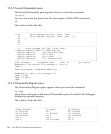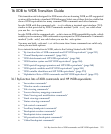
16 XDB to WDB Transition Guide
This transition aid is designed for XDB users who are learning WDB, an HP-supported
version of the industry-standard GDB debugger. Select one of these lists for a table that
shows WDB equivalents for many common XDB commands and other features.
Invoke WDB with the command gdb -tui to obtain a terminal user interface (TUI)
similar to that provided by XDB. Commands marked "(with -tui)" are valid when
you use the -tui option.
Invoke WDB with the command gdb -xdb to turn on XDB compatibility mode, which
enables you to use many XDB commands as synonyms for GDB commands. Commands
marked "(with -xdb)" are valid when you use the -xdb option.
You may use both -xdb and -tui at the same time. Some commands are valid only
when you use both options.
For a tutorial introduction to WDB, refer to the Getting Started with WDB.
• “By-function lists of XDB commands and HP WDB equivalents” (page 253)
• “Overall breakpoint commands” (page 260)
• “XDB data formats and HP WDB equivalents” (page 266)
• “XDB location syntax and HP WDB equivalents” (page 268)
• “XDB special language operators and HP WDB equivalents” (page 268)
• “XDB special variables and HP WDB equivalents” (page 269)
• “XDB variable identifiers and HP WDB equivalents” (page 270)
• “Alphabetical lists of XDB commands and HP WDB equivalents” (page 270)
16.1 By-function lists of XDB commands and HP WDB equivalents
• “Invocation commands”
• “Window mode commands”
• “File viewing commands”
• “Source directory mapping commands”
• “Data Viewing and modification commands”
• “Stack viewing commands”
• “Status-viewing command”
• “Job control commands”
• “Auxiliary breakpoint commands”
• “Breakpoint creation commands”
• “Breakpoint status commands”
• “All-procedures breakpoint commands”
• “Global breakpoint commands”
16.1 By-function lists of XDB commands and HP WDB equivalents 253


















